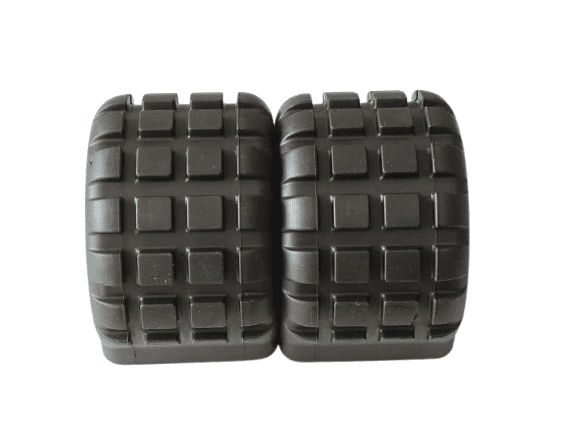Rubber is a key material in many industrial applications. Choosing between SBR and PBR can be tough. Here, I'll break down the differences and help you decide which is better for your needs.
SBR rubber offers better abrasion and chemical resistance, making it suitable for tires and industrial applications, while PBR rubber provides higher elasticity and low-temperature flexibility, primarily used in tire treads and plastic modification.
Wondering which rubber is best for your product? Keep reading to discover the key differences.
What is SBR?
SBR(Styrene-Butadiene Rubber) is a synthetic rubber made by combining styrene and butadiene. It is commonly used in the tire industry, as well as in footwear, hoses, and seals.
SBR is ideal for many general applications but has limitations in specific environments.
SBR
SBR is a versatile material, but it’s important to understand both its advantages and limitations. In terms of wear resistance, SBR performs well under most conditions but does not have the same high durability as some other rubber types. When exposed to oils, SBR degrades faster, which can limit its use in automotive or industrial environments where exposure to fuels and lubricants is common.
Pros of SBR:
- Cost-effective: SBR is typically less expensive than many other synthetic rubbers.
- Good wear resistance: Ideal for tires, footwear, and general-purpose rubber products.
- Good balance of properties: Offers a decent range of temperature and environmental resistance.
Cons of SBR:
- Poor oil resistance: SBR is vulnerable to degradation when exposed to oils, fuels, and solvents.
- Moderate aging resistance: UV and ozone can degrade SBR over time, making it less suitable for outdoor applications.
- Lower performance at low temperatures: SBR becomes brittle in extremely cold conditions.
| Property | SBR (Styrene-Butadiene Rubber) |
|---|---|
| Wear resistance | Good |
| Oil resistance | Poor |
| Aging resistance | Moderate |
| Low-temperature performance | Poor |
What is PBR?
PBR (Polybutadiene Rubber) is another synthetic rubber made from butadiene monomers. It is known for its excellent wear resistance, high resilience, and low-temperature performance, which makes it a top choice in applications like tire manufacturing.
PBR offers superior performance for specific use cases but is less versatile in others.
PBR
PBR stands out due to its remarkable low-temperature performance and excellent resilience. These qualities make it ideal for high-performance tires, which need to maintain flexibility and wear resistance even in cold environments. It also resists oxidation better than SBR, making it more durable over time.
Pros of PBR:
- Superior low-temperature performance: PBR stays flexible even in freezing conditions.
- Excellent wear resistance: Perfect for tires and other high-stress applications.
- Resistant to oxidation: PBR is more durable and ages better than SBR.
Cons of PBR:
- Higher cost: PBR tends to be more expensive than SBR.
- Limited versatility: While it’s great for specific applications, PBR doesn’t perform as well in oil exposure or outdoor settings.
- More complex manufacturing: Producing PBR involves more advanced processes, which can increase costs and production time.
| Property | PBR (Polybutadiene Rubber) |
|---|---|
| Wear resistance | Excellent |
| Oil resistance | Moderate |
| Aging resistance | Excellent |
| Low-temperature performance | Excellent |
Difference Between SBR and PBR Rubber?
The main difference lies in their performance characteristics and cost. While SBR is more affordable and versatile, PBR shines in specific applications that require high wear resistance1 and low-temperature flexibility.
SBR is a general-purpose rubber, while PBR excels in extreme conditions.
SBR vs PBR
When choosing between SBR and PBR, the decision comes down to your specific needs. If your application involves exposure to oils or solvents, SBR may not be the best option. On the other hand, if you need a rubber that performs well at lower temperatures and resists wear over time, PBR would be the better choice.
Both types of rubber have their place, but understanding your specific requirements will help guide your decision.
SBR (Styrene-Butadiene Rubber)2:
- Composition and Structure: A copolymer of styrene and butadiene.
- Advantages:
- High strength and good elasticity.
- More resistant to oxidation and ozone than NR (Natural Rubber), thus more durable.
- Easy to process, with lower costs, good mixing performance, and stable vulcanization properties.
- Good abrasion resistance, high tensile strength, and excellent aging stability.
- More resistant to chemicals than BR (Butadiene Rubber).
- Better thermal stability than BR.
- Disadvantages:
- Poor oil resistance, prone to swelling and degradation upon oil contact.
- Lower elasticity and adhesion compared to NR, with potential hardening at high temperatures.
- Poor resistance to ozone and sunlight.
- Suitable Temperature Range: -40°C to +100°C.
- Main Applications: Tires, industrial seals, gaskets, and shoe soles.
- Advantages:
- Slightly higher elasticity than SBR due to its higher cis-1,4 content.
- Imparts improved tread-wear resistance and low-temperature flexibility in tire applications.
- Disadvantages:
- Poor thermal stability and resistance to oils and fats.
- Main Applications:
- Primarily used in tire treads.
- Used in acrylonitrile-butadiene-styrene resins (ABS Resins) and in high-impact polystyrene (HIPS).
- Found in belts, hoses, footwear, floor coverings, children's toys, and golf balls.
Key Differences:
| Feature | SBR (Styrene-Butadiene Rubber) | PBR (Polybutadiene Rubber) |
|---|---|---|
| Primary Use | Tires, footwear, adhesives, seals, gaskets | Tire treads, modification of plastics, belts, hoses |
| Abrasion Resistance | High | Good |
| Elasticity | Good | Higher |
| Chemical Resistance | Good | Lower |
| Thermal Stability | Better | Poorer |
| Versatility | Higher | Lower |
Choose SBR for high abrasion and chemical resistance. Choose PBR for higher elasticity and low-temperature flexibility.
Conclusion
Both SBR and PBR are widely used in various industries, each offering distinct advantages. SBR is affordable and works well for general applications, while PBR excels in environments requiring high performance and resilience. Understanding your needs and the specific conditions in which your rubber components will be used is key to making the right choice.
-
Learn about various materials that provide high wear resistance, crucial for selecting the right rubber for demanding applications. ↩
-
Explore this link to understand the unique properties and applications of SBR, which can help in making informed decisions for your projects. ↩
-
Discover the advantages and specific applications of PBR, especially in tire manufacturing and other industries, to enhance your knowledge. ↩









